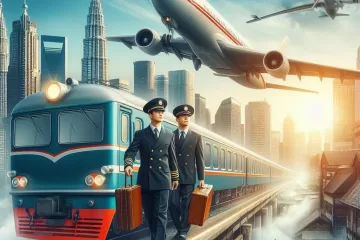The Future of Railways: A Global Push Toward AI-Driven Automation

Railway transportation is undergoing a transformation powered by artificial intelligence and automation. From autonomous trains running on heavy-haul freight lines to AI-based traffic management systems optimizing scheduling and energy consumption, the rail industry worldwide is embracing a future of safer, more efficient, and environmentally friendly operations. This article explores the key players, technologies, and initiatives driving this revolution.
Autonomous Trains: From Mining Rails to High-Speed Networks
Freight and Heavy-Haul Operations
One of the most striking examples of railway automation is Rio Tinto’s AutoHaul project in Western Australia. Launched to operate driverless iron ore trains, AutoHaul covers over 1,900 kilometers of track, marking the world’s first fully autonomous heavy-haul rail network. The trains, which operate without onboard crews and are supervised remotely, have already logged millions of kilometers, showcasing how AI-driven control systems can boost safety and productivity in challenging environments. Collaborations with technology providers like Hitachi Rail have been pivotal in implementing advanced signalling and obstacle detection systems that ensure continuous, efficient operation .
Passenger Rail and Mainline Innovations
In the passenger rail sector, innovation is equally rapid. In Hamburg, Deutsche Bahn and Siemens Mobility demonstrated the world’s first automated, driverless train on a traditional rail network. These trials, part of Germany’s “Digital Rail for Germany” initiative, have introduced Automatic Train Operation (ATO) on S-Bahn commuter services. Although human staff remain onboard as a safeguard, the AI system autonomously handles station stops, speed adjustments, and energy management, promising improvements in capacity and punctuality.
Meanwhile, France’s SNCF, in consortium with industry leaders such as Alstom, Thales, and Bosch, is testing autonomous regional train prototypes. Their efforts, supported by government-backed research, aim to achieve full autonomy in the coming years. In China, the launch of a driverless high-speed bullet train during the Beijing Winter Olympics marked another milestone. This Fuxing high-speed train, operating at 350 km/h, leverages AI, 5G connectivity, and a suite of sensors to automatically manage departures, cruising, and stops—underscoring China’s aggressive pursuit of smart railway technologies .
Startup Innovations in Autonomous Rail
Startups are also making significant strides in autonomous rail technology. Companies like Railspire are retrofitting existing locomotives with AI autopilot systems for railyard operations. These solutions, designed for confined environments like switching yards, blend human oversight with AI precision, enhancing safety and operational efficiency in areas traditionally prone to errors.
AI-Powered Traffic Management and Real-Time Control
Efficient railway operations depend not only on the individual performance of trains but also on the seamless coordination of entire networks. Advanced AI systems are being deployed to manage real-time train movements and schedule adjustments.
Dispatching and Scheduling with AI
Companies such as Wabtec have developed tools like the Movement Planner, an AI-based dispatch system that automatically calculates optimal routes and meet-pass plans for trains. This technology is particularly impactful for freight railroads, where dynamic scheduling and conflict resolution can significantly reduce delays and improve network throughput. By analyzing data on train locations, speeds, and network constraints, AI systems can suggest real-time schedule tweaks that streamline operations .
Disruption Management and Route Reoptimization
Rail operators are increasingly relying on AI to manage disruptions. Hitachi Rail’s hybrid railway traffic management system is designed to quickly reschedule trains during delays or incidents. This system draws on machine learning to mimic the decision-making of experienced controllers, providing swift, data-driven solutions that restore normal operations faster than conventional methods. Similarly, Deutsche Bahn has tested AI tools that flag potential conflicts before they escalate, ensuring proactive adjustments that minimize the impact of delays .
Enhancing Safety Through Vision and Sensing
Safety remains paramount in railway operations. AI-powered vision systems, such as those developed by Rail Vision in Israel, use deep learning and sensor fusion (cameras, LiDAR, and radar) to detect obstacles on tracks up to 2 km ahead. These systems not only alert train operators but can also trigger emergency braking in fully automated setups. Such technologies are crucial for both autonomous trains and traditional operations, ensuring that advanced automation does not compromise safety .
Energy Optimization: Smarter, Greener Rail Operations
In addition to operational efficiency and safety, AI is playing a key role in reducing energy consumption and emissions across the rail network.
Intelligent Cruise Control and Energy Savings
Wabtec’s Trip Optimizer is a prime example of how AI can enhance energy efficiency. By analyzing variables such as track gradients, curves, speed limits, and train weight, Trip Optimizer computes the most energy-efficient driving profiles. Acting like an autopilot, it modulates throttle and braking to conserve fuel, which has resulted in substantial cost savings and a significant reduction in CO₂ emissions. Similar energy management systems in electric train operations leverage regenerative braking and optimized acceleration patterns to further decrease energy usage .
AI in Passenger Rail Efficiency
For passenger rail services, AI not only improves punctuality but also contributes to greener operations. Automated driving profiles in S-Bahn trains, for instance, reduce energy waste by ensuring that acceleration and braking are performed optimally. This results in both lower operational costs and a reduced environmental footprint—a critical advantage as urban transit systems strive for sustainability .
Global Initiatives and Future Outlook
The transformation of railway operations is supported by extensive government and industry initiatives worldwide:
- Germany’s Digital Rail for Germany funds pilot projects like the Hamburg S-Bahn autonomous train, paving the way for nationwide implementation of AI-driven technologies.
- France’s Autonomous Train Consortium brings together major industry players and research institutes to fast-track the development of driverless regional trains.
- China’s Smart Rail Strategy has led to the launch of the world’s first autonomous high-speed train, backed by significant state investment.
- European Union Programs such as Shift2Rail (and its successor, Europe’s Rail) promote cross-border collaboration in developing innovative railway solutions, from autonomous freight operations to intelligent energy management.
These initiatives, combined with rapid advances from startups and established companies alike, point to a near-future where AI and automation are integral to every facet of railway transportation.
Conclusion
AI-driven railway automation is not just a futuristic concept—it is actively reshaping the industry around the globe. With projects ranging from Rio Tinto’s autonomous mining trains and Germany’s driverless S-Bahn services to China’s high-speed bullet trains and innovative startup solutions, the rail sector is on the cusp of a major transformation. By integrating advanced AI for traffic management, safety, and energy efficiency, the industry is poised to deliver unprecedented improvements in reliability, performance, and sustainability. As global initiatives and collaborative research continue to drive these technologies forward, the next decade promises to usher in a new era of smart, autonomous railways.
Author of the Article
Aryaman Chaudhary
Founder Trackster
Also Read…



0 Comments